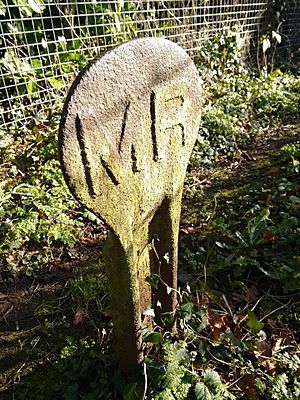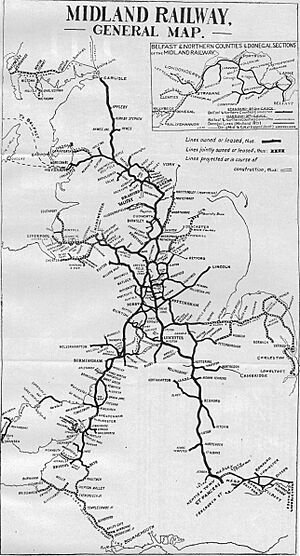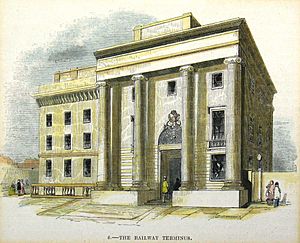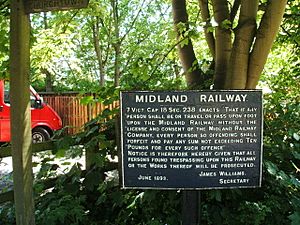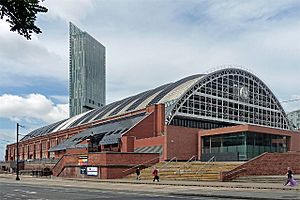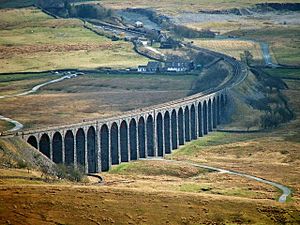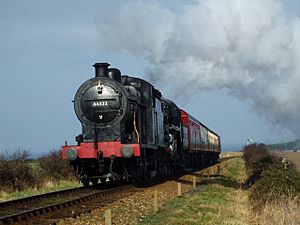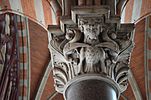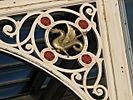Midland Railway facts for kids
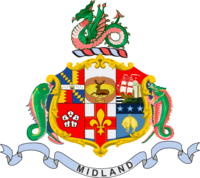 |
|
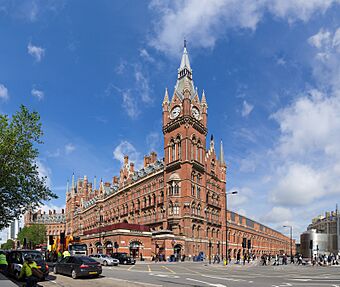
The Midland Grand Hotel at St Pancras station, the London terminus of the Midland Railway in June 2012
|
|
| Overview | |
|---|---|
| Headquarters | Derby |
| Locale | England and Wales |
| Dates of operation | 10 May 1844–31 December 1922 |
| Predecessor | Midland Counties Rly, North Midland Rly, Birmingham and Derby Junction Rly |
| Successor | London, Midland and Scottish Railway |
| Technical | |
| Track gauge | 4 ft 8 1⁄2 in (1,435 mm) standard gauge |
| Length | 2,170 miles 22 chains (3,492.7 km) (1919) |
| Track length | 6,625 miles 48 chains (10,662.9 km) (1919) |
The Midland Railway (often called MR) was a very important railway company in the United Kingdom. It started in 1844. In the early 1900s, it was one of Britain's biggest railway companies. It was also the largest employer in Derby, where its main offices were.
The Midland Railway had a huge network of train lines. These lines started from Derby and reached big cities like London St Pancras, Manchester, Carlisle, Birmingham, and Bristol. The company grew by buying other smaller railway lines. It also ran ships from Heysham to places like Douglas and Belfast.
Many parts of the Midland Railway's old lines are still used today. Examples include the Midland Main Line and the famous Settle–Carlisle line. Some of its old railway hotels are still called Midland Hotel. In 1923, the Midland Railway joined with other companies to form the London, Midland and Scottish Railway.
Contents
- The Story of the Midland Railway
- Companies the Midland Railway Acquired
- Midland Railway Ships
- Symbols of the Midland Railway
- Train Accidents and Incidents
- Important People at Midland Railway
- See also
The Story of the Midland Railway
How the Railway Began
The idea for the Midland Railway started around 1832. It began in Leicestershire and Nottinghamshire. The main goal was to help local coal mine owners transport their coal.
The Midland Railway company officially formed on May 10, 1844. This happened when three smaller railway companies joined together. These were the Midland Counties Railway, the North Midland Railway, and the Birmingham and Derby Junction Railway. Two years later, the Birmingham and Gloucester Railway also joined. These lines met at a special "Tri-Junct station" in Derby. This is where the Midland Railway built its workshops for making and fixing locomotives (train engines) and carriages and wagons.
Important leaders like George Hudson and John Ellis helped guide the new company. The Midland Railway was in a great spot. Its Derby headquarters were at the crossing point of two main routes from London to Scotland. This gave it good connections to other major railway lines.
Growing the Network
The Midland Railway quickly started to grow. In 1845, it took over the Sheffield and Rotherham Railway. It also took control of the Erewash Valley Line. This line gave the company access to important coalfields in Nottinghamshire and Derbyshire. Coal transport became a huge source of money for the Midland Railway.
The company also expanded into the Leicestershire coalfields. It bought the Leicester and Swannington Railway in 1846. This helped them extend their lines even further.
Reaching the South-West
After the companies merged, trains from London used the shorter Midland Counties route. The old Birmingham and Derby Junction Railway line was used for traffic to Birmingham and Bristol. Bristol was a very important seaport.
The line going south was the Birmingham and Bristol Railway. This line reached Curzon Street station. These lines had a problem at Gloucester. Trains had to switch between different track widths (called "gauges"). This meant all goods and passengers had to be moved from one train to another, which caused a lot of delays and confusion.
The Great Western Railway wanted to take over the Bristol to Birmingham route. But the Midland Railway's John Ellis heard about this. He promised that the Midland Railway would offer a better deal. Other railway companies also helped the Midland Railway. They did not want the Great Western Railway to bring its wider tracks into Birmingham. In the end, the Midland Railway shared Birmingham New Street station with another company, the LNWR, when it opened in 1854.
Competition in the East
The Midland Railway controlled most of the train traffic from London to the North East and Scotland. However, there was a push for a direct line from London to York. The Midland Railway decided to build lines to Lincoln and Peterborough. This made it harder for other companies to build new, competing lines to those cities.
In 1844, the Leeds and Bradford Railway was approved. By 1850, it was losing money. George Hudson, from the Midland Railway, made an offer to buy it. This line gave the Midland Railway a way to reach the north. It also became the start of the famous Settle and Carlisle line. It also gave the Midland Railway a much better station at Leeds Wellington.
Despite objections from the Midland Railway, the "London and York Railway" (later called the Great Northern Railway) got permission to build its direct line in 1846.
The Battle of Nottingham
In 1851, a railway line from Grantham reached Colwick, near Nottingham. The Great Northern Railway (GN) and the Midland Railway both wanted to work with this new line. Nottingham wanted more train services. The Midland Railway tried to buy the new line. But a shareholder from the GN had already bought many shares.
The GN tried to join with the new line. But John Ellis from the Midland Railway got a court order to stop the GN from running trains into Nottingham. However, in 1851, the GN started a new service to the north that included Nottingham.
In 1852, a train arrived in Nottingham with a GN engine. When the engine tried to move, a Midland Railway engine blocked its way. Another Midland engine blocked its escape. The GN engine was moved to a shed, and the tracks were removed. This event became known as the "Battle of Nottingham." It took seven months in court before the GN engine was finally released.
Reaching London
Sharing King's Cross (1857–1868)
By 1850, the Midland Railway was more stable. Its leader, John Ellis, knew the company needed to expand. In 1853, James Allport became the general manager. The next step was to stop relying on other railways to reach London.
A plan for a line from Hitchin to King's Cross was approved in 1847. But it had not been built. The plan was brought up again in 1853. It had support from the people of Bedford, who had slow train services.
The new line, called the Leicester and Hitchin Railway, ran from Wigston to Hitchin. It joined the GN line at Hitchin to reach King's Cross. This line helped ease the pressure on other routes. However, the GN insisted that Midland passengers for London had to get off at Hitchin. They had to buy new tickets quickly to catch a GN train to finish their journey.
James Allport made a deal with the GN. For seven years, the Midland Railway could run its trains into King's Cross for £20,000 a year. Through train services to London started in February 1858. Building the Leicester and Hitchin railway cost £1,750,000.
Building St Pancras (1868)
By 1860, the Midland Railway was doing very well. It was carrying three times more coal, iron, and beer. Passenger numbers were also growing. But because GN trains had priority on their own lines, Midland passengers were often delayed. So, in 1862, the company decided to build its own main station in London. This was a big step for a national railway.
On June 22, 1863, a new law was passed. It allowed the Midland Railway to build a new line between London and Bedford. This new line went through Luton. It curved around Hampstead Heath to reach a spot between King's Cross and Euston. The line from Bedford to Moorgate opened for passengers on July 13, 1868. Trains started running into St Pancras station on October 1, 1868.
St Pancras station is a stunning example of Gothic Revival architecture. It includes the beautiful Midland Grand Hotel, designed by Gilbert Scott. The huge iron train shed was designed by William Barlow. Building the station was difficult. It had to go through an old church graveyard. Also, a sewer ran underneath it. A branch line from the main track went underground with a steep slope to connect to another railway line.
Building the London Extension railway cost £9 million.
Connecting to Manchester
From the 1820s, there were ideas for lines from London and the East Midlands to reach Manchester. The Midland Railway teamed up with the Manchester and Birmingham Railway (M&BR). They planned a line from Ambergate. This plan was approved in 1846. The line was built as far as Rowsley by 1849. However, the M&BR had joined the LNWR, which then tried to stop the Midland Railway.
In 1863, the Midland Railway reached Buxton. But the LNWR also arrived from the other direction. The Midland Railway started building an alternative line in 1867. This was to avoid problems with the Ambergate line. The Midland Railway gained control of the original line in 1871. But getting into Manchester was still blocked at Buxton.
Eventually, the Midland Railway made a deal with the Manchester, Sheffield and Lincolnshire Railway (MS&LR). They agreed to share lines from Millers Dale. This became known as the Sheffield and Midland Railway Companies' Committee. The Midland Railway also joined the Cheshire Lines Committee. This allowed them to expand further into Lancashire and Cheshire. Finally, they got a new station at Manchester Central.
Sheffield also got a main-line station. The Midland Railway built a new line into a station at Pond Street. One of the last major lines built by the Midland Railway connected Sheffield and Manchester. This line opened in 1894. It went through the Totley and Cowburn Tunnels. This line is now called the Hope Valley Line.
Reaching Scotland
In the 1870s, the Midland Railway had a disagreement with the London and North Western Railway (LNWR). This was about using the LNWR line to Scotland. Because of this, the Midland Railway decided to build its own line to Scotland. This was the Settle and Carlisle line. It is the highest main railway line in England.
The disagreement with the LNWR was resolved before the Settle and Carlisle line was finished. But Parliament would not let the Midland Railway stop building it. Scottish railway companies also wanted the line. It would help them compete with the Caledonian Railway for traffic to Glasgow and Edinburgh. So, the Midland Railway had to finish the Settle to Carlisle line, which opened in 1876.
Later Years and the End of an Era
The Nottingham direct line of the Midland Railway opened for goods trains in December 1879. It opened for passenger trains in March 1880. By the mid-1880s, the company was doing very well. Passenger travel was increasing with new, comfortable trains. The main business, transporting goods and minerals, was growing a lot.
By the early 1900s, the amount of goods, especially coal, was so large that it was slowing down the entire network. Passenger trains were often late. Sir Guy Granet became the general manager in 1905. He introduced a new system to control traffic. He also created a system for classifying locomotive power. This system later became a model for British Railways.
The Midland Railway bought other lines, including the Belfast and Northern Counties Railway in 1903. It also bought the London, Tilbury and Southend Railway in 1912. It worked with many other railways, owning more "Joint" lines than any other company. For example, it partnered with the GN to own the Midland and Great Northern Joint Railway. This was the UK's biggest joint railway.
In 1913, the company made over £15 million in revenue.
First World War and Joining Other Railways
When the First World War started in 1914, the government took control of all major railways, including the Midland. The Midland Railway still operated independently. It was given money to match its 1913 income. But it had to carry huge amounts of military goods. This meant there was little chance to maintain the railway lines and trains.
After the war, the railways were worn out. It was clear that things could not go back to how they were before. So, the government passed the Railways Act 1921. This law combined all the main railway lines into four new, large companies. This process was called the "Grouping." The Midland Railway became a part of the new London, Midland and Scottish Railway (LMS) starting in 1923. At that time, the LMS was the largest company of its kind in the world.
Companies the Midland Railway Acquired
- Ashby Canal and Tramway (joined 1846)
- Barnoldswick Railway (leased 1871, joined 1899)
- Bedford and Northampton Railway (leased 1872, joined 1885)
- Northern Counties Committee (in Ireland)
- Birmingham and Gloucester Railway (leased 1845, joined 1846)
- Birmingham West Suburban Railway (joined 1875)
- Bristol and Gloucester Railway (joined 1846)
- Burton and Ashby Light Railway (leased 1906)
- Chesterfield and Brampton Railway (joined 1871)
- Cromford Canal (joined 1871)
- Dore and Chinley Railway (joined 1888)
- Erewash Valley Railway (joined 1845)
- Evesham and Redditch Railway (leased 1868, joined 1882)
- Hemel Hempsted Railway (leased 1877, joined 1886)
- Hereford, Hay and Brecon Railway (leased 1869, joined 1886)
- Keighley and Worth Valley Railway (joined 1881)
- Kettering, Thrapston and Huntingdon Railway (joined 1897)
- Leeds and Bradford Railway (leased 1846, joined 1851)
- Leeds and Bradford Extension Railway (joined 1851)
- Leicester and Swannington Railway (joined 1846)
- London, Tilbury and Southend Railway (purchased 1912, joined 1920)
- Manchester, Buxton, Matlock and Midland Junction Railway (leased 1852, joined 1871)
- Manchester South District Railway (joined 1877)
- Mansfield and Pinxton Railway (joined 1848)
- Midland and South Western Junction Railway (joined 1874)
- North Western Railway (leased 1859)
- Oakham Canal (joined 1846)
- Redditch Railway (leased 1858, joined 1874)
- Sheffield and Rotherham Railway (joined 1845)
- Stonehouse and Nailsworth Railway (joined 1886)
- Swansea Vale Railway (leased 1874, joined 1876)
- Syston and Peterborough Railway (joined 1846)
- Tewkesbury and Malvern Railway (joined 1876)
- Wolverhampton and Walsall Railway (joined 1876)
- Wolverhampton, Walsall and Midland Junction Railway (joined 1874)
Midland Railway Ships
The Midland Railway also had its own ships. These ships sailed from Heysham to Douglas and Belfast.
Symbols of the Midland Railway
The Midland Railway's coat of arms combined symbols from several cities. These included Birmingham, Derby, Bristol, Leicester, Lincoln, and Leeds. The wyvern, a mythical dragon with two legs, was a very common symbol for the Midland Railway. They got this symbol from the Leicester and Swannington Railway.
The Midland Railway claimed the wyvern was a symbol of the ancient Kingdom of Mercia. They also said it was part of Leicester's town arms. The wyvern appeared on almost everything the company owned. This included station buildings, bridges, and even items in their hotels. All uniformed employees wore a silver wyvern badge. However, later research showed there was no real link between the wyvern and the Kingdom of Mercia. It has been linked to Leicester since the 1200s.
Train Accidents and Incidents
- In June 1850, a train's boiler exploded at Kegworth railway station, Nottinghamshire.
- In 1850, a train crashed into the back of another train at Woodlesford station. A signal light was not working at night.
- In 1853, a train's boiler exploded near Bristol, Gloucestershire.
- On September 9, 1867, a cattle train crashed into a parked train in Dove Holes Tunnel. An 11-year-old girl riding unofficially in the train was killed.
- On August 28, 1875, a passenger train went past signals and crashed into the back of another train at Kildwick. Seven people died and 39 were hurt.
- On August 11, 1880, a passenger train went off the tracks at Wennington, Lancashire. Eight people died and 23 were injured.
- On August 19, 1880, a passenger train stopped inside Blea Moor Tunnel. Another train crashed into it at low speed.
- On August 27, 1887, an express passenger train went past signals and crashed into a freight train at Wath station. Twenty-two people were injured.
- On June 9, 1892, a passenger train went past signals and crashed into another train at Esholt Junction. Five people died and 30 were injured.
- On December 3, 1892, a freight train crashed at Wymondham Junction, damaging the signal box.
- On September 2, 1898, an express passenger train went off the tracks at Wellingborough. This happened because a trolley fell onto the track. Seven people died and 65 were injured.
- On July 24, 1900, a passenger train went off the tracks at Amberswood, Lancashire. One person died.
- On December 1, 1900, a freight train went off the tracks at Peckwash near Duffield, Derbyshire.
- On December 23, 1904, an express passenger train went off the tracks at Aylesbury. This was due to going too fast on a curve. Another train crashed into the wreckage. Four people died.
- On January 19, 1905, an express passenger train went past signals and crashed into a passenger train at Cudworth. Seven people died.
- In June 1907, a luggage train went off the tracks after the driver misread signals.
- On December 24, 1910, an express passenger train crashed into two light engines near Moorcock Tunnel. This was due to mistakes by the signalman and firemen. The train went off the tracks and caught fire. Twelve people died and seventeen were injured.
- On September 2, 1913, a passenger train went past a signal and crashed into the back of another passenger train near Ais Gill. Sixteen people died and 38 were injured.
Important People at Midland Railway
- Chairmen
- George Hudson (1844 – 1849)
- John Ellis (1849 – 1856)
- William Evans Hutchinson (1864 – 1870)
- William Philip Price (1870 – 1873)
- Edward Shipley Ellis (1873 – 1879)
- Matthew William Thompson (1880 – 1890)
- (George) Ernest Paget (1890 – 1911)
- George Murray Smith (1911 – 1919)
- Charles Booth (1919 – 1922)
- (William) Guy Granet (1922 – 1923)
- General Managers
- Joseph Sanders (1849 – 1853)
- James Joseph Allport (1853 – 1857)
- W. L. Newcombe (1857 – 1860)
- James Joseph Allport (1860 – 1880)
- John Noble (1880 – 1892)
- George Henry Turner (1892 – 1901)
- John Mathieson (1901 – 1905)
- (William) Guy Granet (1905 – 1918)
- Frank Tatlow (1918 – 1922)
- Locomotive Leaders and Chief Engineers
- Matthew Kirtley (1844 – 1873)
- Samuel Waite Johnson (1873 – 1904)
- Richard Deeley (1904 – 1909)
- Henry Fowler (1909 – 1923)
- James Anderson (1915 – 1919, temporary)
- Resident Engineers
- William Henry Barlow (1842 – 1857)
- Chief Architect
- John Holloway Sanders (around 1854 – 1884)
- Charles Trubshaw (1884 – 1905)
- Solicitors
- Samuel Carter MP (1835 – 1868)
See also
 In Spanish: Ferrocarril de Midland para niños
In Spanish: Ferrocarril de Midland para niños
- Midland Railway War Memorial, Derby
- Locomotives of the Midland Railway


